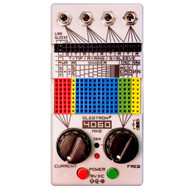Olegtron - 4060 MK2
by Andy Simmons
The Olegtron 4060 MK2 is a compact oscillator/frequency divider box capable of creating signals and sequences through a revolutionary programming method: sticking electronic components to its patchboard! The device can be used as a standalone sound generator or as a CV signal generator to a wide variety of machines, such as modular synthesizers or anything that accepts control voltage. When used as a CV generator the 4060 can easily deliver complex results that would normally require a large system.
The name of the device comes from the CD4060 integrated circuit chip. It belongs to the 4000b series of CMOS logic chips and interfaces with other chips of the series seamlessly. The series dates back to the sixties, but is still relevant in sound electronics and DIY. The CD4060 contains an oscillator with adjustable frequency, and a frequency divider that outputs 10 different sub-frequencies.
The Olegtron 4060 is based on an RC-oscillator example from the CD4060 datasheet, with the addition of a current limiting potentiometer that kind of simulates a weak battery. The Olegtron MK2 can take between 3 and 15v for power but this standalone unit asks for 9v. Any voltage higher or lower than this will make the output signal stronger or weaker. While I ended up using a 9v battery for all of my testing, if using a wall wart instead of a battery, the tip has to be center positive, which is important to note because it is the opposite of the more commonly available guitar pedal adapters out there, so you might have to do some hunting around.
The Olegtron MK2 has 4 stereo outputs that can be patched to be mono or stereo and as inputs or outputs. It ships with a bag of components to get started with, including patch cables, electrolytic capacitors, ceramic capacitors and resistors or varying values, with the provided resistors and small capacitors being color coded for clearness.
All patching is done via breadboard in colored sections; Red is for the power, blue for the frequency divider, green is oscillator, and yellow is for a sawtooth waveform. There is one more yellow strip next to the power section that is a reset. Documentation is important for this because you are messing with circuitry and putting in capacitors and resistors at random has a chance to short some out and cause some damage. All cautions and tips for patching are listed in the documentation, and as this is an extremely well documented piece of gear from the manufacturer,I strongly urge anyone interested to read up on the published materials.
Really, Olegtron is a sandbox, and pretty much anything is possible as you can bring any components into it, and with all of the possibilities and printed graphics it's a little overwhelming at first. While using it doesn’t require any previous electronics skills, experimenting with different electronic components helps you get the idea how they work, and your programming can become more systematic. I made it my mission it to see how “big” of a sound I could get out of the stereo output. I spent a lot of time with different oscillators patched to the left and right, keeping a rhythm going while altering my patches and playing it. You can mess around and change the octaves of the oscillator with the components and utilize sub frequencies with the divider. You can make very abstract rhythms utilizing the reset strip. You can change what the knobs affect by following the lines and patching off of them. Thinking about the Olegtron many patches came to mind: A stand alone sound generator where you can plug it directly into your amp or headphones [start with low volume!]. You could use it as synth control by sending CV, clock, and gate signals to your synth and from the synth to 4060. The Olegtron could serve as a DIYer's test signal generator, you could feed amplified signals into the 4060 and output them with a lo-fi flavor, and even use it to sequence lights by connecting single or multicolored LEDs straight into the unit or via a driver. With the Olegtron you could combine the above examples and still keep everything in the same fluctuating sync.
There are a few caveats about the Olegtron that I should mention. First, the case is plastic, and not something I would toss with my other gear to lug around. Also, make sure you have a good battery in it if you take it anywhere, as changing the battery is not a quick and easy thing as one screw on the underside of the unit holds it all together and it's a tight fit. Also, having breadboard-style patching is awesome but can have its downsides. The Olegtron 4060 MK2 allows you to do a lot in a small space, but it gets busy quick and doing stuff on the fly or in a live setting would be very difficult and take a lot of practice to master.
I started my electronic music journey with circuit bending and my excitement and love for the Olegtron is pretty biased because of this. The 4060 is a blast to use and it can be a noise musician’s dream in a compact package, or an abstract modulator and processor for the imaginative. It stays exciting because of the myriad of possibilities, but takes some work to get the hang of, at least in the beginning, but I can see it becoming much easier as you gain experience—just like most things in a typical Eurorack system. If you’re willing to put in the time, The Olegtron 4060 MK2 is one of the most unique pieces of equipment out there.
Price: $129


